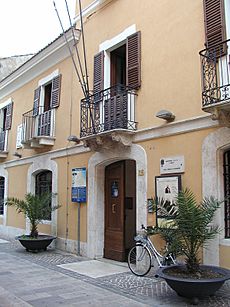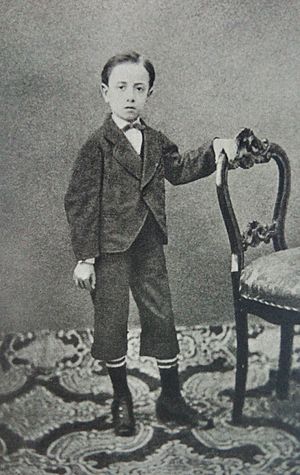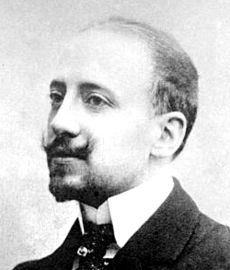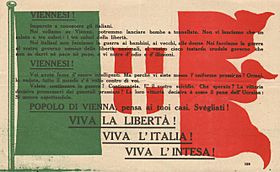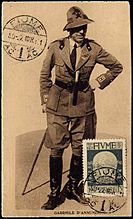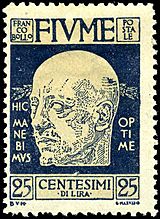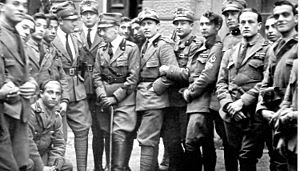Gabriele D'Annunzio facts for kids
Gabriele D'Annunzio, Prince of Montenevoso, was an important Italian poet, writer, and soldier. He was born on March 12, 1863, and passed away on March 1, 1938. He was known as "The Poet" or "The Prophet."
D'Annunzio was part of a literary style called the Decadent movement. This style focused on beauty and emotion in writing. He was also influenced by the philosopher Friedrich Nietzsche.
During World War I, D'Annunzio became a national hero in Italy. He was a brave pilot in the Italian Army. After the war, he led a group of Italian nationalists to take control of the city of Fiume. He created a short-lived state there called the Italian Regency of Carnaro. His ideas and style influenced Benito Mussolini and the rise of Italian fascism.
Quick facts for kids
Gabriele D'Annunzio
Prince of Montenevoso
OMS CMG MVM |
|
|---|---|
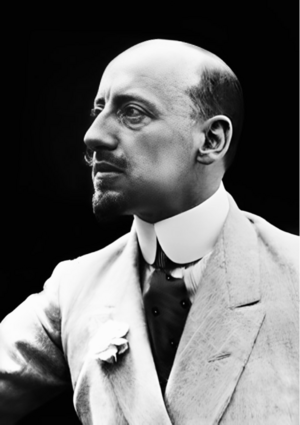 |
|
| Comandante of the Carnaro | |
| In office 12 September 1919 – 30 December 1920 |
|
| Preceded by | Office created |
| Succeeded by | Office abolished (Riccardo Zanella as President of the Free State of Fiume) |
| Member of the Chamber of Deputies | |
| In office 5 April 1897 – 17 May 1900 |
|
| Constituency | Ortona a Mare |
| Personal details | |
| Born | 12 March 1863 Pescara, Italy |
| Died | 1 March 1938 (aged 74) Gardone Riviera, Italy |
| Resting place | Vittoriale degli italiani, Gardone Riviera, Lake Garda |
| Political party | Historical Right (1897–1898) Historical Far Left (1898–1900) Italian Nationalist Association (1910–1923) |
| Spouse |
Maria Hardouin
(m. 1883) |
| Domestic partner | Eleonora Duse (1898–1901) |
| Children |
|
| Parents | Francesco Paolo Rapagnetta and Luisa de Benedictis |
| Profession | Journalist, poet, soldier |
| Nicknames | Il Vate ("The Poet"); Il Profeta ("The Prophet") |
| Military service | |
| Branch/service | Royal Air Force |
| Years of service | 1915–18 |
| Rank | General (honorary) Lieutenant colonel Major Lieutenant colonel |
| Unit | 3rd Army Arditi |
| Battles/wars |
|
| Writing career | |
| Period | 20th century |
| Genre | Poetry, novel |
| Subject | Individualism, existentialism |
| Literary movement | Decadence |
| Years active | 1879–1938 |
| Notable works |
|
| Signature | |
Contents
Biography
Early Life and Education
Gabriele D'Annunzio was born in Pescara, Italy, on March 12, 1863. His father was a wealthy landowner and the mayor of the town. Gabriele showed great talent from a young age.
He went to school in Prato, Tuscany. At just 16, he published his first book of poems called Primo Vere. His writing was so good that a famous critic praised him. In 1881, D'Annunzio went to the University of Rome. There, he joined literary groups and wrote for newspapers.
Literary Career
D'Annunzio wrote many books of poetry and short stories. His early works described the sea and the Italian countryside. Later, his writing style became more unique. He explored complex emotions and experiences.
Some of his famous novels include Il Piacere (The Child of Pleasure) and Il trionfo della morte (The Triumph of Death). He also wrote plays, like La Gioconda and Francesca da Rimini. His play Francesca da Rimini was even turned into an opera.
D'Annunzio was known for his dramatic lifestyle. He married Maria Hardouin di Gallese in 1883 and had three sons. He also had a notable relationship with the actress Eleonora Duse, for whom he wrote leading roles in his plays.
In 1897, D'Annunzio was elected to the Italian Parliament. By 1910, he had financial problems and moved to France. While there, he worked with famous composers like Claude Debussy and Pietro Mascagni on musical plays. The Vatican, the center of the Catholic Church, even placed all his works on their list of forbidden books.
D'Annunzio also helped start the Popular University of Milan in 1901. He was involved in a group called the Scottish Rite Great Lodge of Italy, which used symbols like the Ouroboros and the seven stars of the Ursa Major.
Role in World War I
When World War I began, D'Annunzio returned to Italy. He gave speeches encouraging Italy to join the war. He was very interested in flying and became a fighter pilot. He gained more fame as a war hero, even losing sight in one eye in a flying accident.
In February 1918, he took part in a daring raid on the harbor of Bakar. This event helped boost the spirits of the Italian people. On August 9, 1918, he led nine planes on a 700-mile flight over Vienna. During this flight, they dropped propaganda leaflets. This famous event is known as "the Flight over Vienna."
The Fiume Expedition
After the war, D'Annunzio was upset that the city of Fiume, which had many Italian speakers, was not given to Italy. On September 12, 1919, he led about 2,000 Italian nationalists to take over the city. They forced the Allied forces (American, British, and French) to leave.
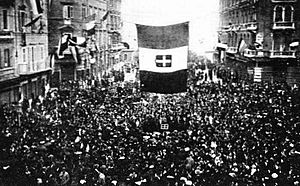
D'Annunzio declared Fiume an independent state called the Italian Regency of Carnaro. He called himself "Duce," meaning leader. The rules he set for Fiume, called the Charter of Carnaro, included music as a main principle of the state. He even tried to create a group for oppressed nations around the world. Italy blockaded Fiume and demanded the group surrender. D'Annunzio declared war on Italy itself. He finally gave up the city on December 29, 1920, after the Italian navy attacked.
Later Life and Legacy
After the Fiume event, D'Annunzio moved to his home on Lake Garda. He spent his later years writing. Although his ideas influenced Benito Mussolini, D'Annunzio never joined the fascist government directly. In 1924, the King of Italy gave him the title of Prince of Montenevoso.
In 1937, he became president of the Royal Academy of Italy. D'Annunzio died in 1938 from a stroke at his home. He received a state funeral and was buried in a grand tomb at his estate, the Vittoriale degli Italiani.
His son, Gabriellino D'Annunzio, became a film director. His 1921 film The Ship was based on his father's novel.
Politics and Influence
Many people see D'Annunzio as someone who helped shape the ideas of Italian fascism. The rules he created for Fiume, the Charter of Carnaro, included ideas that later appeared in fascism. This included a system where different parts of society (workers, employers) were represented. The Charter also famously stated that music was a main principle of the state.
D'Annunzio controlled Fiume using a "politics of spectacle." This meant he used dramatic speeches and ceremonies to keep power. Benito Mussolini copied many of these methods. D'Annunzio is sometimes called the "John the Baptist of Italian Fascism." This is because he invented many of the rituals that fascism later used. These included speaking from a balcony, the Roman salute, and using black-shirted followers.
D'Annunzio believed Italy should expand its power. He supported Italy's invasion of Ethiopia. He also tried to influence Mussolini, even writing to him in 1933 to warn against allying with Hitler. In 1937, he met Mussolini to try and convince him to leave the Axis alliance.
Literary Works
D'Annunzio was celebrated for his unique and powerful writing. His work had a big impact across Europe. His novels often featured strong emotions and vivid descriptions. One of his most famous poems is "La pioggia nel pineto" (The Rain in the Pinewood). This poem shows his skill with language and his focus on sensory details.
He also wrote the screenplay for the film Cabiria (1914), which was a historical epic. D'Annunzio's work was even part of the literature competition at the 1912 Summer Olympics.
Museums
D'Annunzio's life and work are remembered in a museum called Il Vittoriale degli Italiani. He designed this complex himself near his home on Lake Garda. It includes a military museum, a library, a theater, and his tomb. The museum displays his torpedo boat and the plane he flew over Vienna.
His birthplace in Pescara is also open to the public as the Birthplace of Gabriele D'Annunzio Museum.
Works
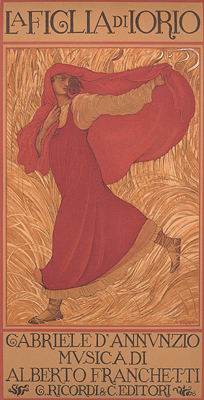
Novels
- Il Piacere (The Child of Pleasure, 1889)
- Giovanni Episcopo (1891)
- L'innocente (The Intruder (UK) or The Victim (US)) (1892)
- Il trionfo della morte (The Triumph of Death, 1894)
- Le vergini delle rocce (The Maidens of the Rocks, 1895)
- Il fuoco (The Flame of Life: A Novel, 1900)
- Forse che sì forse che no (Maybe Yes, Maybe No, 1910)
Plays (Tragedies)
- La città morta (The Dead City: a Tragedy, 1899)
- La Gioconda (Gioconda, 1899)
- Francesca da Rimini (1902)
- La figlia di Jorio (The Daughter of Jorio, 1904)
- La fiaccola sotto il moggio (The Torch Under the Bushel, 1905)
- La nave (1908)
Short Story Collections
- Terra vergine (1882)
- Le novelle della Pescara (1884–1886)
Poetry Collections
- Primo vere (1879)
- Canto novo (1882)
- Poema paradisiaco (1893)
- The five books of Laudi del cielo, del mare, della terra e degli eroi (1903–1912)
- Maia (Canto Amebeo della Guerra)
- Elettra
- Alcyone
- Merope
- Asterope (La Canzone del Quarnaro)
Autobiographical Works
- Notturno
Filmography
- Cabiria, directed by Giovanni Pastrone (1914) – screenplay
Films About Gabriele D'Annunzio
- D'Annunzio, directed by Sergio Nasca (1985)
- The Bad Poet, directed by Vincenzo Jodice (2020)
Legacy
- D'Annunzio University in Chieti and Pescara is named after him.
- The Brescia Airport is named after him.
- The Chilean poetess Gabriela Mistral, who won the Nobel Prize in Literature, chose her first name in his honor.
- The play Tamara is based on his meeting with the painter Tamara de Lempicka.
- Luchino Visconti's last film, The Innocent, is based on D'Annunzio's novel.
Images for kids
See also
 In Spanish: Gabriele D'Annunzio para niños
In Spanish: Gabriele D'Annunzio para niños


